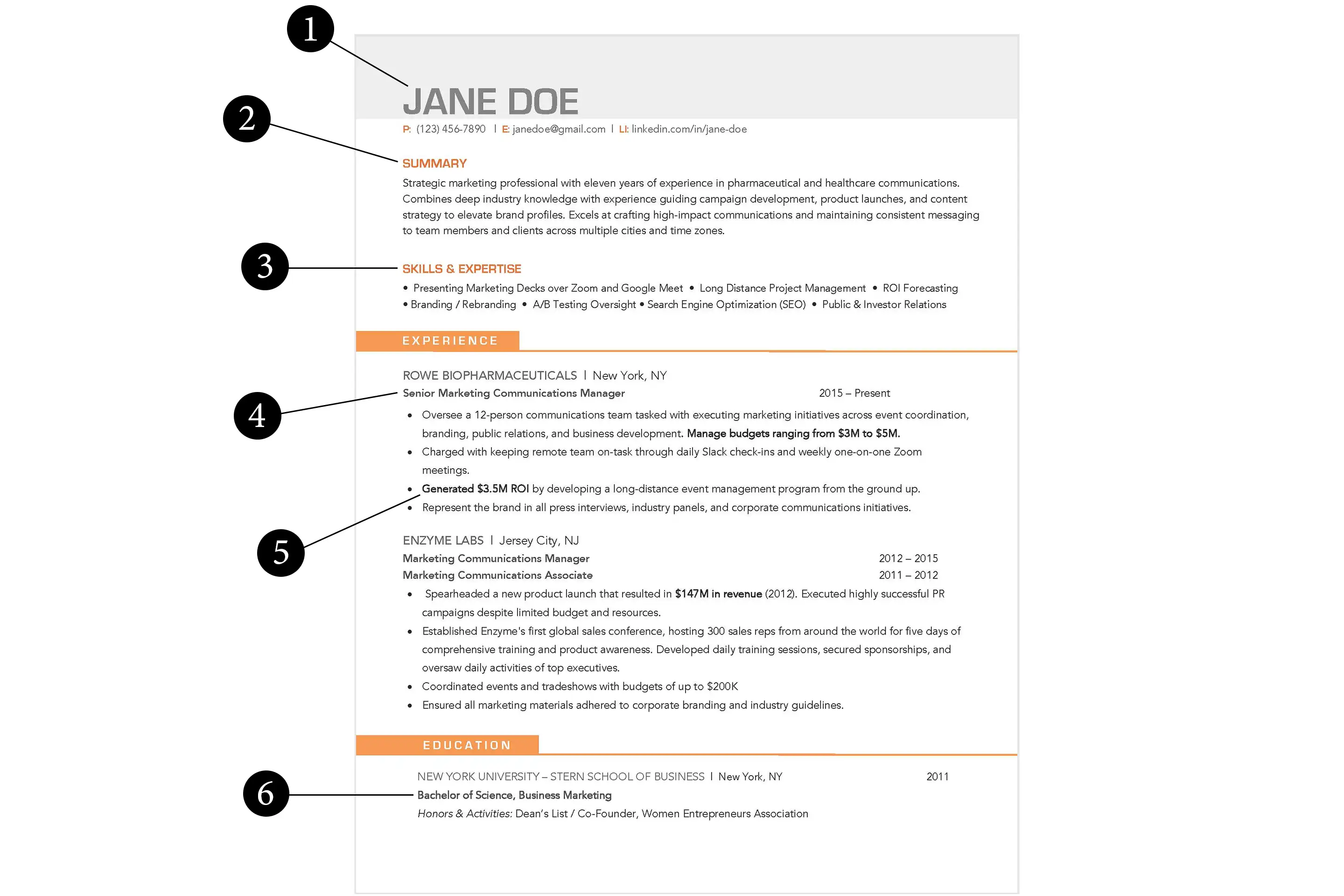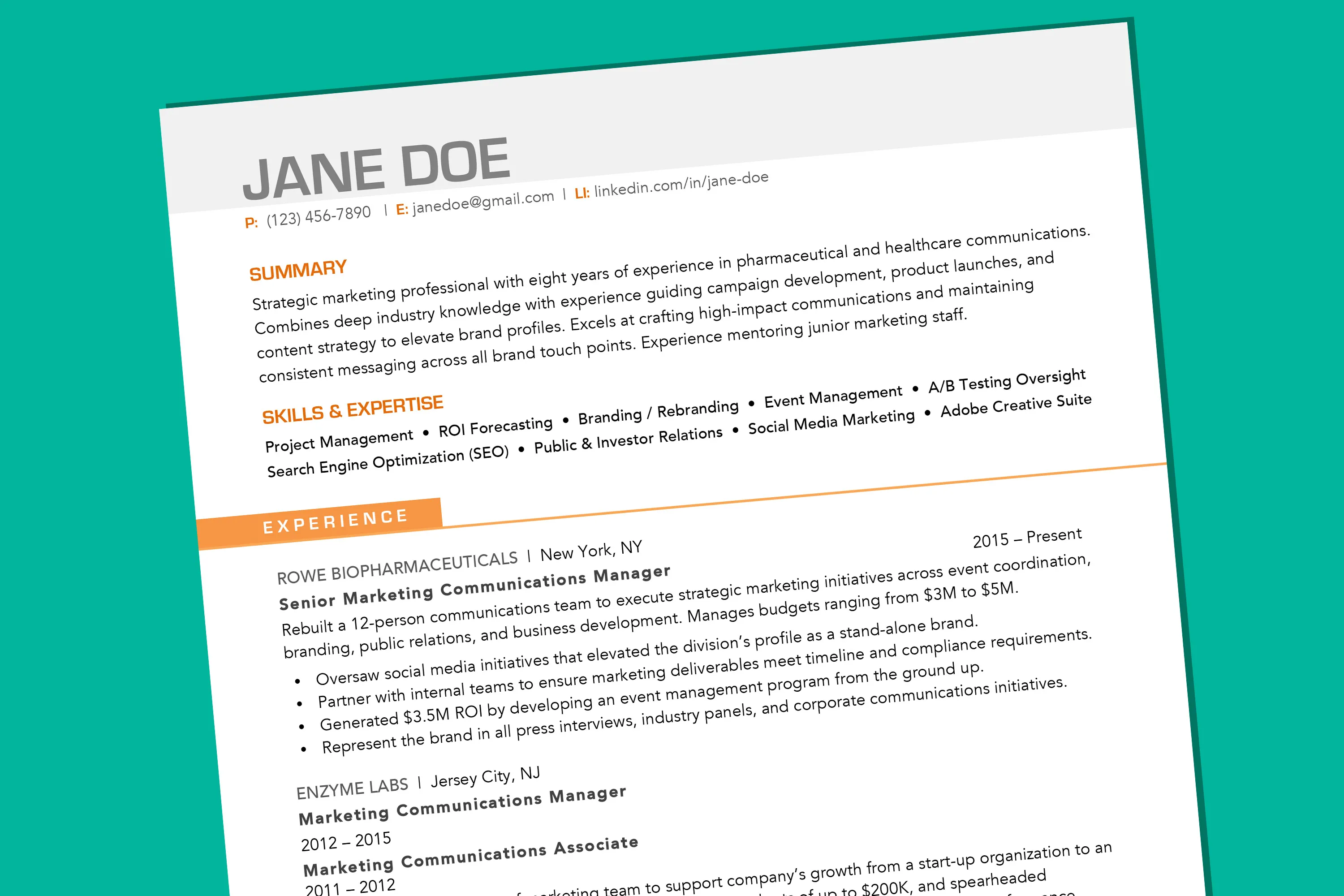Resumes tend to get a bad rap.
We write them begrudgingly, usually during periods of transition, or tumult. We fiddle with phrasing and format, agonizing over how to present our skills and qualifications in the best light possible.
But the truth is, it doesn’t have to be so complicated.
A resume is a just tool — much like a cover letter or LinkedIn profile — for grabbing a hiring manager’s attention. It should be simple, professional and laser-focused on what you bring to the table. And while you’ll need to periodically give it a refresh, adding new keywords and relevant accomplishments, brevity is key.
Here’s a step-by-step guide to crafting a resume recruiters can’t overlook — with a free template you can download and customize.

1. Choose a smart format and font
Let’s be blunt: The job market is brutal. Hiring is down, unemployment is up and wages have stalled, according to a recent report from the Labor Department. To stand out in this ever-crowded field, you may be tempted to jazz up your resume with creative elements like video intros, headshots or infographics.
This isn’t a bad strategy if you’re, say, a graphic designer. But for most job seekers, a traditional layout (reverse chronological order; left-aligned) with a clean, no-frills format is still the way to go. This is especially true if you’re applying through a company’s online hiring portal or through a job posting site like Indeed. These sites sift through massive volumes of resumes using Applicant Tracking Systems (ATS), which ignore photos and graphics at best, or, at worst, automatically reject applicants who use them.
Be sure to use the same font style throughout, says Dana Leavy-Detrick, founder of Brooklyn Resume Studio, but play with different weights and sizes to draw a recruiter’s eye to key parts of your resume. Sans serif fonts usually work best — Franklin Gothic, Calibri, and Avenir (the last of which we used for the downloadable template) are three of Leavy-Detrick’s favorites.
2. Add a pop of color
If you’re applying for an investment banking job, a hot-pink resume probably won’t do you any favors. But subtle pops of color, like the orange used here, will work for just about everyone. “It’s very minimal, and gives a bit of a design element,” Leavy-Detrick says.
However, if you do use color, “Stick to one color,” she warns, and “use it sparingly.”
A note on length: If you’re not applying for an executive position, keep your resume to one page. This is a highlight reel, not an autobiography, so showcase your most impressive accomplishments and leave out the rest.
3. Highlight the right skills
Lead with the good stuff. The top of your resume should include “critical keywords and a quick snapshot of your core strengths,” Leavy-Detrick says.
Hard skills, or tangible attributes that can easily be measured, take precedence here. If you’re in a tech-driven field, software and programming expertise is what employers want to see on your resume. If you’re in sales, marketing or a creative industry, showcase your experience with data and analytics software like Excel, Salesforce and Oracle or project management tools like Asana, Trello and Jira.
4. Quantify your impact
To craft a compelling case, zero in on proven results. Statistics that build upon your skills section are most impactful — bonus points if they show a track record of growth, revenue and profitability, Leavy-Detrick says.
If you’re drawing a blank, she suggests nodding to things that could help solve a “problem area” for the company you’re applying to, like improving customer retention, internal processes or even company culture.
“Impact doesn’t always have to be measured by metrics,” she says.
5. Cut irrelevant information
Be discerning with the content — don’t list salary requirements, or tick off every job you’ve ever had. The same goes for social media profiles. Unless your Instagram and TikTok feeds are relevant to the job you’re applying for, it’s probably best to leave those off.
“The resume is a high-level snapshot of your skills, experience, and accomplishments,” Leavy-Detrick says. If a hiring manager has to scan through an excessively detailed one, “they’re more likely to miss key responsibilities.”
6. Make your resume AI friendly
Don’t make the mistake of answering each job posting with the same generic resume. Instead, take a few extra minutes to mirror it to the keywords and phrases within the job ad. You’ll be much more likely to make it to the next round of hiring if the company is using artificial intelligence or a computer-generated tracking system to weed out candidates.
“Get as close as you can to the language of the job description, or at least look for common denominators,” Leavy-Detrick advises.
If you’re planning to cast a wide net by uploading a general resume to your LinkedIn or Indeed profile, make sure it’s tailored to the primary job you want — then update your keywords when applying to positions that deviate from the norm.
7. Know what recruiters are looking for
Workers need to be flexible these days, and so do their resumes. It’s nearly impossible to avoid change — whether it be updates to technology, staffing or workflow. Now more than ever, proving your ability to adapt is the key to
finding (and keeping) a job.
This is especially true for older job seekers, who “aren’t perceived to be as versatile as their younger counterparts when it comes to technology,” Leavy-Detrick says.
If you fall into that category, she says, be sure to emphasize the digital skills you have experience in, like email marketing, social media or cybersecurity.
8. Strike the perfect balance
Omitting information can make recruiters suspicious, especially if there are large gaps in your employment history. So make sure your resume doesn’t have too much white space, or gaps in time, without providing a bit of context. If you worked outside of your current industry while between jobs, for instance, nod to that in a brief “additional experience” section.
Still, refrain from including every little detail about your personal life — if you took some time off to raise a family, or self-publish a novel, you’re probably better off leaving that for the cover letter.
